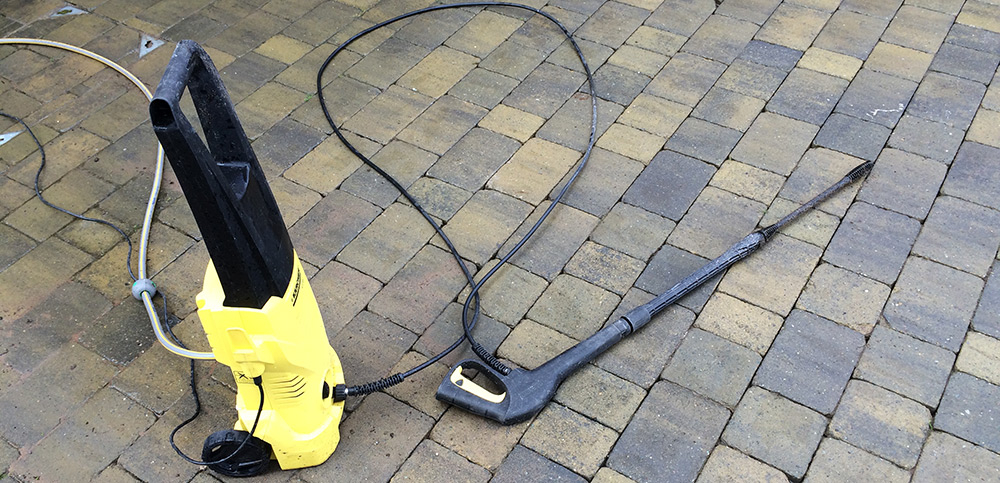Cleaning Natural Stone Patios and Block Paving Driveways
Cleaning Patio Slabs
Your brand new patio has had a dose of the good old English weather and now looks like a green, mossy, algae-covered mess. Spring is approaching and you really want it to look good as new again. On this page we look at the procedures to take to give your patio that much-needed spring clean along with methods of preventing or limiting, this happening again.
Step 1 - Pressure Wash
Grab a pressure washer and give your paving a strong blast of water.
You have to be careful when using a pressure washer that you don’t blast the joints too much and damage it, so just make sure you focus the pressure on the actual slabs.
The pressure of the water will be able to clear off any grime that is stuck on your patio

Step 2 - Outdoor Cleaner
Once you have used the pressure washer, you’ll be able to spot any particularly stubborn bits of dirt and grime.
Lithofin - MN Outdoor Cleaner can be used to clean the slabs as your next step. Simply apply with a sprayer and then leave for between 2 - 10 hours. The surface can then be brushed, or you can give it another blast from your pressure washer. If your slabs are particularly dirty, you can repeat this step.
Step 3 - Treat
Your next step is to treat your paving. Lithofin - Algex - Moss and Mould Remover has a penetrative effect that not only breaks down moss and mould, it also helps prevent it for up to one year.
You should dilute this down with water and then distribute the surface using either a watering can or a sprayer. Once this is applied the area should be left untouched for at least 4 hours.
After a few days, you will notice the surfaces will become bright, clean and free of deposits. This can then be washed off with water or left and rinsed away by the rain.
Step 4 - Seal
Sealing the paving is an optional final step, though if you want to prevent more mess we would definitely recommend doing this.
One of the market leaders is Lithofin - Stain Stop which provides optimal protection for absorbent natural and artificial stone surfaces. It mostly prevents oil, water and grease penetration and simplifies maintenance.
A cheaper alternative to this is Geofix Natural Stone Protector which works well on sandstone paving in particular.
Hopefully by now your patio should be looking like its former self and ready to enjoy your time outdoors on it.
Cleaning Block Paving Driveways
Driveways always get plenty of ware and tare. It may be the turning of the wheels on cars causing rubber marks, builders sloshing cement where they shouldn’t be or just mother nature trying to take the land back.
Whatever it may be there is always a time when a driveway needs a bit of tender loving care. Below we will go through some simple steps to help you get your driveway back to its former self.

Step 1 - Pressure Washer
Similarly to cleaning patio slabs, the first step is to blast your driveway with a pressure washer.
The aim of this is to clean the tops of the blocks and all of the joints of any microbes which could cause plants to grow in between the slabs.
You have to be quite methodical for this job, we found the best was to do one row of blocks at a time.
Only move to the next row once completely satisfied with the first. The driveway below took 3 hours for 50m2.
We would advise that waterproof clothing be worn, a face mask is optional, but eye protection is essential.
Be prepared to get very dirty. It is best to move as much as possible out of the way as the dirt gets absolutely everywhere.
When you finally finish, it is a good idea to let the area dry and then it is much easier to see if you have missed any areas.
There were some streak marks left on this driveway, hardly noticeable, but would annoy the perfectionist!

Step 2 - Joints
Using Jointex, a joint stabilising alkali sand, brush this in between the joints of the block paving.
This will help to secure your block paving and replace any that were lost in the process of pressure washing.
It is permanently water permeable, resistant to high-pressure cleaners and prevents weeds from sprouting.
Step 3 - Seal
Seal the slabs using either hardseal or cementone pave shield.This step is optional, though using a seal will expand the longevity of your block paving by providing a protective layer.
Sealing will protect the surface from staining, as well as eliminating the growth of algae and significantly reducing the chances of weed growth. It also prolongs the lifespan of your paving by binding together jointing sand to increase the strength and enhancing the colour to prevent fading.
